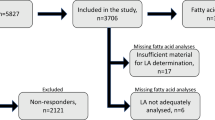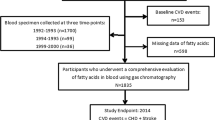Abstract
BACKGROUND/OBJECTIVES:
Lower circulating polyunsaturated fatty acids (PUFAs) may induce loss of heart function. We investigated whether lower concentrations of n-3 and n-6 PUFAs were associated with less favourable echocardiographic measures and higher heart rate in older Caucasians, cross-sectionally and after 7 years of follow-up.
SUBJECTS/METHODS:
We used data from the Hoorn Study, a population-based cohort. Cross-sectional data were available for 621 participants and longitudinal data for 336 participants. Mean age was 68.6±6.8 years at baseline. We performed linear regression analyses using n-3 and n-6 PUFAs quartiles—assayed by gas liquid chromatography—with left ventricular ejection fraction (LVEF), left ventricular mass index, left atrial volume index and heart rate.
RESULTS:
In multivariable analyses (regression coefficient (95% confidence interval)), the lowest eicosapentaenoic acid and docosahexaenoic acid quartiles compared with the highest quartiles were cross-sectionally associated with lower LVEF. Lower eicosapentaenoic acid and docosahexaenoic acid concentrations were associated with higher heart rate: 3.7 b.p.m. (1.5, 6.0; P for trend <0.001) and 3.4 b.p.m. (1.2, 5.6; P for trend 0.001), respectively. Multivariate longitudinal analyses showed a significant trend across quartiles for alpha-linolenic acid in relation to LVEF. The lowest linoleic acid quartile was significantly associated with a decreased LVEF of −4.0% compared with the highest quartile.
CONCLUSIONS:
This study found no strong evidence of longitudinal associations of eicosapentaenoic acid and docosahexaenoic acid with echocardiographic measures, however, lower concentrations of alpha-linolenic acid and linoleic acid were associated with decreased LVEF. These results provide evidence for a potential protective role of alpha-linolenic acid and linoleic acid in relation to systolic function.
This is a preview of subscription content, access via your institution
Access options
Subscribe to this journal
Receive 12 print issues and online access
$259.00 per year
only $21.58 per issue
Buy this article
- Purchase on Springer Link
- Instant access to full article PDF
Prices may be subject to local taxes which are calculated during checkout
Similar content being viewed by others
References
Roger VL, Go AS, Lloyd-Jones DM, Benjamin EJ, Berry JD, Borden WB et al. Heart disease and stroke statistics -2012 update: a report from the American Heart Association. Circulation 2012; 125: e2–e220.
Bleumink GS, Knetsch AM, Sturkenboom MC, Straus SM, Hofman A, Deckers JW et al. Quantifying the heart failure epidemic: prevalence, incidence rate, lifetime risk and prognosis of heart failure The Rotterdam Study. Eur Heart J 2004; 25: 1614–1619.
Goldberg RJ, Spencer FA, Farmer C, Meyer TE, Pezzella S . Incidence and hospital death rates associated with heart failure: a community-wide perspective. Am J Med 2005; 118: 728–734.
Robertson J, McElduff P, Pearson SA, Henry DA, Inder KJ, Attia JR . The health services burden of heart failure: an analysis using linked population health data-sets. BMC Health Serv Res 2012; 12: 103.
Geleijnse JM, Giltay EJ, Grobbee DE, Donders AR, Kok FJ . Blood pressure response to fish oil supplementation: metaregression analysis of randomized trials. J Hypertens 2002; 20: 1493–1499.
Ghio S, Scelsi L, Latini R, Masson S, Eleuteri E, Palvarini M et al. Effects of n–3 polyunsaturated fatty acids and of rosuvastatin on left ventricular function in chronic heart failure: a substudy of GISSI-HF trial. Eur J Heart Failure 2010; 12: 1345–1353.
Nodari S, Triggiani M, Campia U, Manerba A, Milesi G, Cesana BM et al. Effects of n-3 polyunsaturated fatty acids on left ventricular function and functional capacity in patients with dilated cardiomyopathy. J Am Coll Cardiol 2011; 57: 870–879.
Mozaffarian D, Wu JH . Omega-3 fatty acids and cardiovascular disease: effects on risk factors, molecular pathways, and clinical events. J Am Coll Cardiol 2011; 58: 2047–2067.
Mozaffarian D, Geelen A, Brouwer IA, Geleijnse JM, Zock PL, Katan MB . Effect of fish oil on heart rate in humans: a meta-analysis of randomized controlled trials. Circulation 2005; 112: 1945–1952.
Anderson JS, Nettleton JA, Hundley WG, Tsai MY, Steffen LM, Lemaitre RN et al. Associations of plasma phospholipid omega-6 and omega-3 polyunsaturated fatty acid levels and MRI measures of cardiovascular structure and function: the multiethnic study of atherosclerosis. J Nutr Metab 2011; 2011: 315134.
Khaw KT, Friesen MD, Riboli E, Luben R, Wareham N . Plasma phospholipid fatty acid concentration and incident coronary heart disease in men and women: the EPIC-Norfolk prospective study. PLoS Med 2012; 9: e1001255.
Djoussé L, Akinkuolie AO, Wu JH, Ding EL, Gaziano JM . Fish consumption, omega-3 fatty acids and risk of heart failure: a meta-analysis. Clin Nutr 2012; 31: 846–853.
Patel PS, Sharp SJ, Jansen E, Luben RN, Khaw KT, Wareham NJ et al. Fatty acids measured in plasma and erythrocyte-membrane phospholipids and derived by food-frequency questionnaire and the risk of new-onset type 2 diabetes: a pilot study in the European Prospective Investigation into Cancer and Nutrition (EPIC)-Norfolk cohort. Am J Clin Nutr 2010; 92: 1214–1222.
Mooy JM, Grootenhuis PA, de Vries H, Valkenburg HA, Bouter LM, Kostense PJ et al. Prevalence and determinants of glucose intolerance in a Dutch caucasian population. The Hoorn Study. Diabetes Care 1995; 18: 1270–1273.
Spijkerman AM, Adriaanse MC, Dekker JM, Nijpels G, Stehouwer CD, Bouter LM et al. Diabetic patients detected by population-based stepwise screening already have a diabetic cardiovascular risk profile. Diabetes Care 2002; 25: 1784–1789.
Henry RM, Kostense PJ, Spijkerman AM, Dekker JM, Nijpels G, Heine RJ et al. Arterial stiffness increases with deteriorating glucose tolerance status: the Hoorn Study. Circulation 2003; 107: 2089–2095.
Henry RM, Kamp O, Kostense PJ, Spijkerman AM, Dekker JM, van Eijck R et al. Left ventricular mass increases with deteriorating glucose tolerance, especially in women: independence of increased arterial stiffness or decreased flow-mediated dilation: the Hoorn study. Diabetes Care 2004; 27: 522–529.
de Simone G, Gottdiener JS, Chinali M, Maurer MS . Left ventricular mass predicts heart failure not related to previous myocardial infarction: the Cardiovascular Health Study. Eur Heart J 2008; 29: 741–747.
Pritchett AM, Mahoney DW, Jacobsen SJ, Rodeheffer RJ, Karon BL, Redfield MM . Diastolic dysfunction and left atrial volume: a population-based study. J Am Coll Cardiol 2005; 45: 87–92.
van Ballegooijen AJ, Visser M, Snijder M, Dekker JM, Nijpels G, Stehouwer CDA et al. Serum 25-hydroxyvitamin D and parathyroid hormone in relation to plasma B-type natriuretic peptide: the Hoorn Study. Endocr Connect 2012; 1: 48–57.
World Health Organisation. Definition and Diagnosis of Diabetes Mellitus and Intermediate Hyperglycemia. A report of a WHO/IDF consultation: Geneva, Switzerland, 2006.
van Dam RM, Snijder MB, Dekker JM, Stehouwer CD, Bouter LM, Heine RJ et al. Potentially modifiable determinants of vitamin D status in an older population in The Netherlands: the Hoorn Study. Am J Clin Nutr 2007; 85: 755–761.
Mozaffarian D, Gottdiener JS, Siscovick DS . Intake of tuna or other broiled or baked fish versus fried fish and cardiac structure, function, and hemodynamics. Am J Cardiol 2006; 97: 216–222.
Moertl D, Hammer A, Steiner S, Hutuleac R, Vonbank K, Berger R . Dose-dependent effects of omega-3-polyunsaturated fatty acids on systolic left ventricular function, endothelial function, and markers of inflammation in chronic heart failure of nonischemic origin: a double-blind, placebo-controlled, 3-arm study. Am Heart J 2011; 161: e911–e919.
Calder PC . Polyunsaturated fatty acids and inflammatory processes: New twists in an old tale. Biochimie 2009; 91: 791–795.
Ramsden CE, Zamora D, Leelarthaepin B, Majchrzak-Hong SF, Faurot KR, Suchindran CM et al. Use of dietary linoleic acid for secondary prevention of coronary heart disease and death: evaluation of recovered data from the Sydney Diet Heart Study and updated meta-analysis. BMJ 2013; 346: e8707.
Choo J, Ueshima H, Curb JD, Shin C, Evans RW, El-Saed A et al. Serum n-6 fatty acids and lipoprotein subclasses in middle-aged men: the population-based cross-sectional ERA-JUMP study. Am J Clin Nutr 2010; 91: 1195–1203.
Arab L, Akbar J . Biomarkers and the measurement of fatty acids. Public Health Nutr 2002; 5: 865–871.
Acknowledgements
We thank the study participants and the Hoorn Study group staff for their contribution. This work was supported by the Royal Netherlands Academy of Arts and Sciences, the Research Council of Norway and The Charles Wolfson Charitable Trust.
Author information
Authors and Affiliations
Corresponding author
Ethics declarations
Competing interests
The authors declare no conflict of interest.
Additional information
Supplementary Information accompanies this paper on European Journal of Clinical Nutrition website
Rights and permissions
About this article
Cite this article
Reinders, I., van Ballegooijen, A., Visser, M. et al. Associations of serum n-3 and n-6 polyunsaturated fatty acids with echocardiographic measures among older adults: the Hoorn Study. Eur J Clin Nutr 67, 1277–1283 (2013). https://doi.org/10.1038/ejcn.2013.167
Received:
Revised:
Accepted:
Published:
Issue Date:
DOI: https://doi.org/10.1038/ejcn.2013.167



